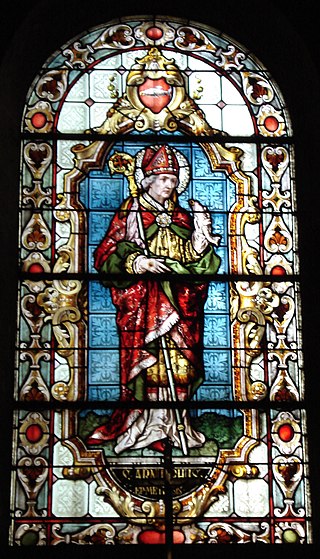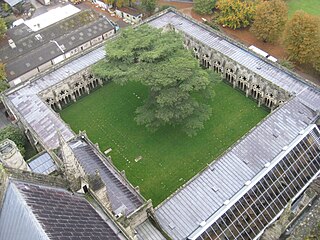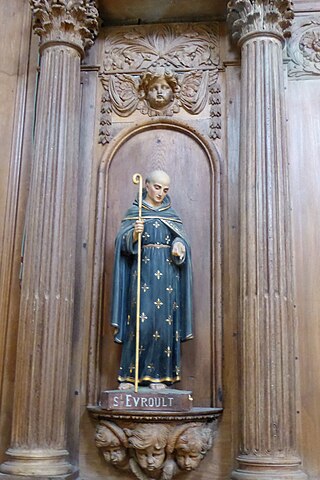Angilbert, Count of Ponthieu was a noble Frankish poet who was educated under Alcuin and served Charlemagne as a secretary, diplomat, and son-in-law. He is venerated as a pre-Congregation saint and is still honored on the day of his death, 18 February.

Year 790 (DCCXC) was a common year starting on Friday of the Julian calendar, the 790th year of the Common Era (CE) and Anno Domini (AD) designations, the 790th year of the 1st millennium, the 90th year of the 8th century, and the 1st year of the 790s decade. The denomination 790 for this year has been used since the early medieval period, when the Anno Domini calendar era became the prevalent method in Europe for naming years.

Willibrord was an Anglo-Saxon monk, bishop, and missionary. He became the first Bishop of Utrecht in what is now the Netherlands, dying at Echternach in Luxembourg, and is known as the "Apostle to the Frisians".

Arnulf of Metz was a Frankish bishop of Metz and advisor to the Merovingian court of Austrasia. He later retired to the Abbey of Remiremont. In French he is also known as Arnoul or Arnoulf. In English he is known as Arnold.

A cloister is a covered walk, open gallery, or open arcade running along the walls of buildings and forming a quadrangle or garth. The attachment of a cloister to a cathedral or church, commonly against a warm southern flank, usually indicates that it is part of a monastic foundation, "forming a continuous and solid architectural barrier... that effectively separates the world of the monks from that of the serfs and workmen, whose lives and works went forward outside and around the cloister."

Saint Giles, also known as Giles the Hermit, was a hermit or monk active in the lower Rhône most likely in the 7th century. Revered as a saint, his cult became widely diffused but his hagiography is mostly legendary. A town that bears his name grew up around the monastery he purportedly founded, which became a pilgrimage centre and a stop on the Way of Saint James. He is traditionally one of the Fourteen Holy Helpers.

Lay abbot is a name used to designate a layman on whom a king or someone in authority bestowed an abbey as a reward for services rendered; he had charge of the estate belonging to it, and was entitled to part of the income. The custom existed principally in the Frankish Empire from the eighth century until the ecclesiastical reforms of the eleventh.

Wigbert, (Wihtberht) born in Wessex around 675, was an Anglo-Saxon Benedictine monk and a missionary and disciple of Boniface who travelled with the latter in Frisia and northern and central Germany to convert the local tribes to Christianity. His feast day is August 13 in the Roman Catholic Church and the Eastern Orthodox Church.

April 25 - Eastern Orthodox liturgical calendar - April 27

May 22 - Eastern Orthodox Church calendar - May 24
Waldebert, , was a Frankish count of Guines, Ponthieu and Saint-Pol who became abbot of Luxeuil, and eventually a canonized saint in the Roman Catholic Church and Eastern Orthodox Church. Like several among his kinsmen, he protected the Church, enriched it with lands and founded monasteries. His brother was Faro.

Saint-Riquier is a commune in the Somme department in Hauts-de-France in northern France.

Saint Walaric, modern French Valery, was a Frankish monk turned hermit who founded the abbey of Saint-Valery-sur-Somme. His cult was recognized in Normandy and England.

Saint Vigor was a French bishop and Christian missionary.

Ebrulf (517–596) was a Frankish hermit, abbot, and saint.

Maurontius of Douai was a nobleman and Benedictine abbot. His parents were Rictrude and Adalbard. He is a Catholic saint, with a feast day on May 5, especially venerated in Douai, France. His sisters Clotsinda, Adalsinda and Eusebia of Douai are also saints.
Saint Judoc, otherwise known as Jodoc, Joyce or Josse was a seventh-century Breton noble considered to be a saint. Judoc was a son of Juthael, King of Brittany. He renounced his wealth and position to become a priest and lived alone for the rest of his lifetime in the coastal forest near the mouth of the River Canche.

Paulus of Verdun (576-648) was a bishop of Verdun in the Lorraine region of France from 630 until his death in 647 or 648.
Adalbert I of Ostrevent was a 7th-century Frankish nobleman of the court of King Clovis II of France. He is recognized as a saint, and is commemorated on both 2 February and 2 May.
Baugulf was a prominent Benedictine abbot in the Carolingian church. He was the second abbot of the Abbey of Fulda in present-day Germany. He served from 779 to 802 CE and was succeeded by Ratgar.
















